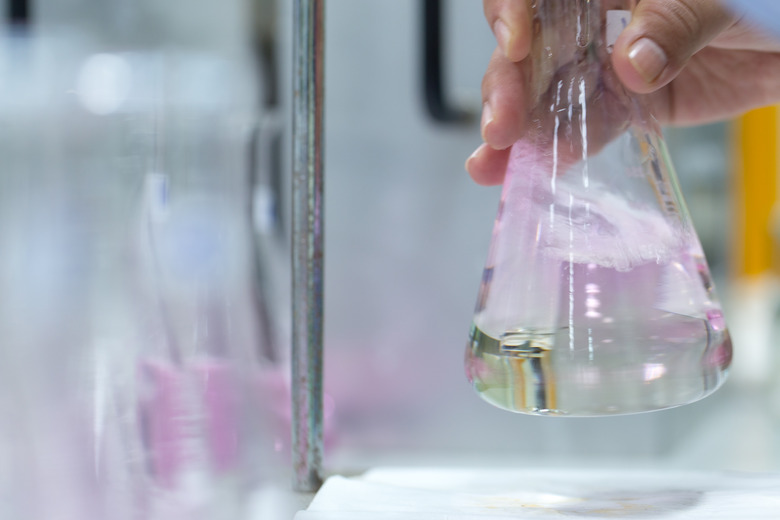Acid Base Titration Sources Of Error Improvements
Chemists use acid-base reactions, in conjunction with an indicator (a compound that changes color when in acidic or basic conditions), to analyze the amount of acid or base in a substance. The amount of acetic acid in vinegar, for example, can be determined by titrating a sample of the vinegar against a strong base such as sodium hydroxide. The method generally involves adding a titrant (in this case, the sodium hydroxide) to an analyte (the vinegar). The exact amount of base in the titrant must be exactly known to achieve accurate results; that is, the titrant must first be "standardized." Then the amount of titrant required to neutralize the acid in the vinegar must be precisely measured.
A skilled operator can achieve results with errors less than 0.1 percent, although such results typically require substantial practice and familiarity with the equipment. Beginners tend to focus on achieving a "perfect" end point to the titration, where the indicator teeters on its transition from acidic to basic. Accurately reaching the end point of the titration, however, is only one component to achieving an accurate result. By the time the titration is actually carried out, significant error will usually have already crept into the experiment from a variety of sources.
Check the calibration of the balance
Check the calibration of the balance
Although acid-base titrations are carried out in the liquid phase, one or more steps usually involves weighing a solid reagent on a balance. Sodium hydroxide, for example, is standardized by titrating potassium hydrogen phthalate (KHP) that is weighed on an analytical (0.0001 gram) balance. Never assume that a balance is level or properly calibrated. The calibration procedures vary from one balance manufacturer to another; refer to the operator's manual. Students should consult their instructor before attempting a recalibration.
Verify that the primary standard is properly dried
Verify that the primary standard is properly dried
Most of the primary standards used to standardize titrants must be thoroughly dried in an oven, usually for several hours, prior to use. They must then be cooled to room temperature and stored in a desiccator to ensure that they do not absorb moisture from the atmosphere. Any absorbed moisture will result an erroneously high titrant concentration.
Verify the precision of the glassware
Verify the precision of the glassware
If the analyte (the sample being analyzed) is a liquid, verify that the glassware used to measure it possesses the requisite precision. Volumetric pipets should be used to precisely measure volumes; they are generally accurate to within 0.02 ml.
Use sufficient quantities of analyte and titrant
Use sufficient quantities of analyte and titrant
Measured volumes should always be 10.00 milliliters (ml) or greater and measured masses should be 0.1 grams or greater. This pertains to the number of significant figures in the final result. If 10.00 ml of a liquid analyte is pipetted into a flask, and at least 10.00 ml of titrant is consumed in the titration, then the final result will be precise to four significant figures. The significance of this should not be overlooked. Statistically, determining the percent acetic acid in vinegar to be 5.525 percent is much more precise (and difficult) than determining it to be 5.5 percent.
Realize the limitations of the equipment
Realize the limitations of the equipment
The accuracy of volumetric glassware is limited, and not all volumetric glassware is created equally. Burets, for example, are generally classified as B or A (the class will be marked on the buret). A class-A buret will typically be precise to within 0.05 ml. A class-B buret, however, may only be precise to within 0.1 mll. This represents a doubling increase in the uncertainty of the buret's volume measurement. In the case of using a class-B buret, the operator should understand that a final result with 0.1 percent error is not realistic.
Cite This Article
MLA
Brubaker, Jack. "Acid Base Titration Sources Of Error Improvements" sciencing.com, https://www.sciencing.com/acid-titration-sources-error-improvements-6370031/. 13 March 2018.
APA
Brubaker, Jack. (2018, March 13). Acid Base Titration Sources Of Error Improvements. sciencing.com. Retrieved from https://www.sciencing.com/acid-titration-sources-error-improvements-6370031/
Chicago
Brubaker, Jack. Acid Base Titration Sources Of Error Improvements last modified August 30, 2022. https://www.sciencing.com/acid-titration-sources-error-improvements-6370031/
